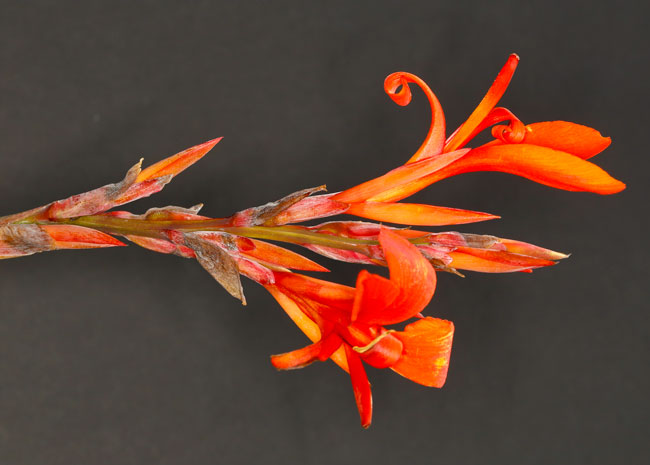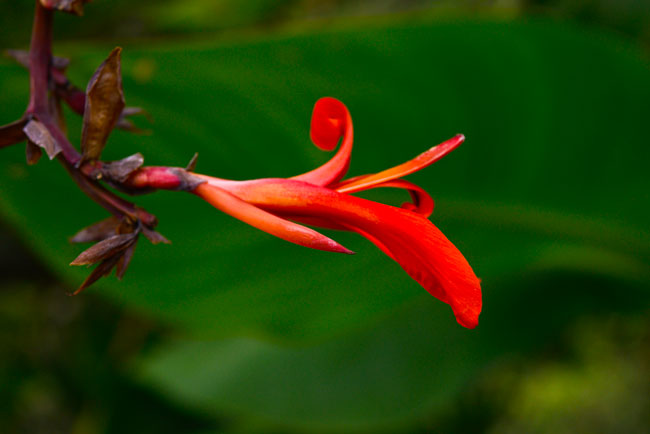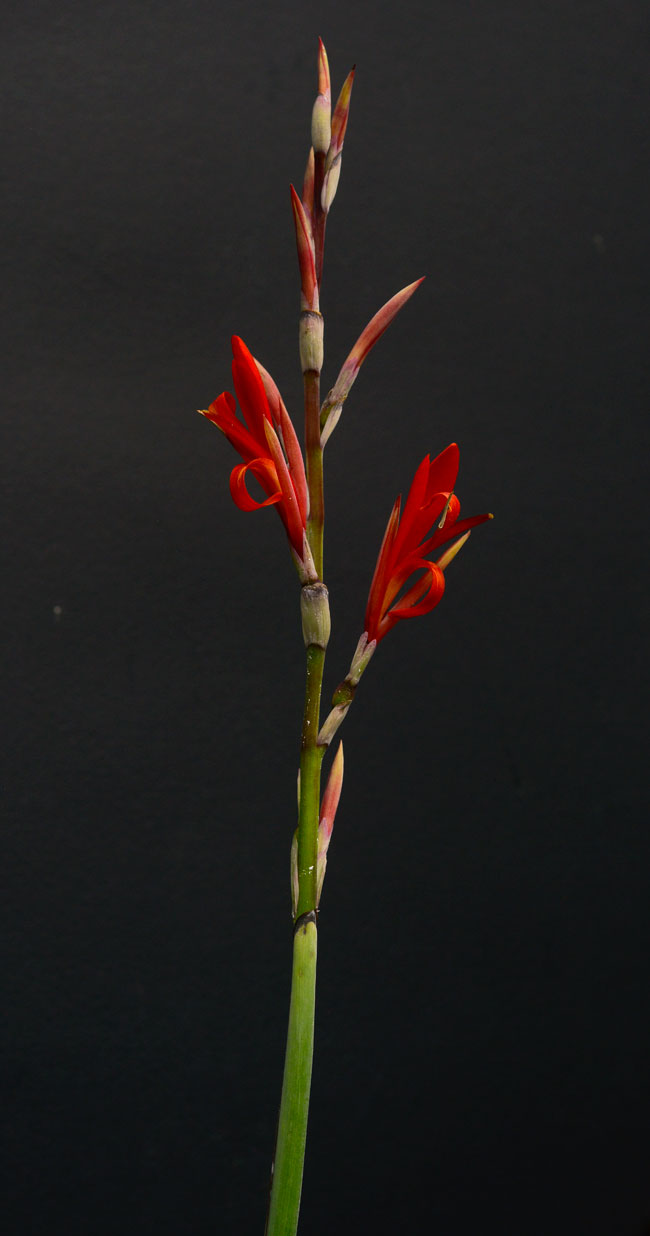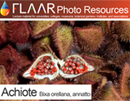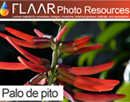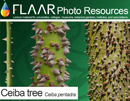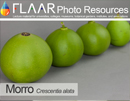When time and funding permit, each flower (each plant species) will have its own page, and its own PDF, and eventually its own PPT so that professors and students have plenty of material on Guatemala (and Honduras, etc) to study.
Heliconia adflexa, Coban, Guatemala, Hotel Monja Blanca, FLAAR, by Nicholas Hellmuth
This space is for flowers
we have recently found and photographed.
|
| Share
|
| Canna indica, Mayan food plant, medicinal plant, and attractive red flower for gardeners |
|
Canna indica leaf as tamale wrap The most common use for this plant is the leaf as a wrap for maize tamales. Canna indica is known throughout Guatemala for this. The leaves are sold at most local Mayan markets, even in larger cities. I would assume that this leaf is selected over leaves of other plants because of a characteristic which is not yet explained in the literature. My guess is due to flavor, since there are a lot of cheaper alternatives, such as banana leaves. However the leaf of Canna is a much more appropriate size (one leaf to wrap one tamale). With a banana leaf it is huge and has to be cut into segments. In addition to banana leaves, there are many native Heliconia species widely available in many parts of Guatemala (Heliconia is a relative of the banana and Bird of Paradise, both of which are not native to Guatemala; however banana is probably the single most common plant in Mayan areas, more common than most fruit trees). Ironically Canna is a distant relative of Heliconia and bananas (Wikipedia, Heliconia). Would help to have field work to ascertain whether only banana leaves are used, or whether Heliconia leaves are also used.
Canna indica is a ornamental species, used widely as a garden plant Although the leaves are widely used to wrap tamales, the plant is even more widely grown primarily as an ornamental plant. I had it in my garden long before I realized that Canna indica had multiple uses (far more than just wrapping tamales).
Canna indica is also edible, medicinal: It is ironic that although Canna indica is native to Mesoamerica, it has more medicinal uses in Africa, Indonesia, and Vietnam than in Guatemala. All these uses raise the logical question of was Canna indica part of Mayan agriculture or kitchen gardens a thousand years ago? Today Canna indica is mainly used for its leaves to wrap tamales, since there are potatoes and many other root crops to replace the time consuming preparation of the Canna indica rhizome. And since there are more than 400 medicinal plants in Guatemala (and several thousand in the larger area of Mexico) perhaps the medicinal aspects are not as needed today. It would definitely be a valid project for a botanist, ethnobotanist, linguist, or agronomist to do field work in all the traditional Mayan speaking areas of Mesoamerica to see what other uses this plant has among the local people. We asked out Q’eqchi’ gardener and our Kakchiquel and other Q’eqchi’ staff and they all praised the Canna indica leaf for tamale wrap. Indeed one of our staff sells the leaves at the local village market during major holiday seasons (when it is the tradition to eat tamales). Common names of Canna indica Canna lily, platanillo, plus words in every local language or dialect. Family Cannaceae. In Peru the name for Canna is achira. It is often confusing whether Canna edulis is a synonym for Canna indica, or whether these are separate species. We are using the name Canna indica for the plant in Guatemala. When does Canna indica flower We photographed the flowers of Canna indica near Tecpan in July. All the plants were in full flower. I estimate this plant blooms many months out of the year. Names in Mayan languages for Canna indica There are 21 Mayan languages in Guatemala alone, and several more in Mexico. Usually a single plant will have up to a dozen different names among all these languages. Here is one sample: chan k'ala' (Yucatec Maya) (www.cicy.mx). We are preparing discussions of the three best ways of photographing colorful flowers: with natural sunlight, with flash, or with studio lighting (or with any two of these together). How to photograph flowers with sunlight How to photograph flowers with flash How to photograph flowers with sstudio lightning The plant We find this plant wild (between Solola, above Lake Atitlan and the main highway). Plus this plant is in gardens all around the country. We had it in our garden but either it did not reproduce or it got shaded out by the hundreds of other species in our limited research garden space. The plants above Tecpan were at least 2 meters high. Most photographs do not show the plant this high. This part of Tecpan is pine forests, but in all openings and along all highways you get lots of different species of medicinal plants and colorants. The plants we studied were in a garden area near a house, so we assume these are not wild. But even wild they get rather tall, as we saw in the mountains far above Lake Atitlan, towards the main international highway, along a river (so in a swampy area). Bibliography on Canna Indica We are moving forward preparing a bibliography on Canna indica. So far we have found almost nothing for Canna in Guatemala (yes, it is native here; yes it is well known and frequently used for wrapping tamales, but so far no thesis or formal study of uses among the Mayan people). Most studies on Canna indica are for Asia, Africa, India.
First posted July 15, 2015, as part of our long term research |
Parque Nacional Yaxha, Nakum and Naranjo
Carnivorous Plants
Plants of Municipio de Livingston, Izabal
- Acrostichum danaeifolium, giant leather ferns
- Bellucia Pentamera
- Bibliography on Grias cauliflora
- Bibliography on Licania platypus
- Bibliography on Mangle negro (Avicennia germinans) L.
- Bibliography on Montriacardia arborescens
- Bibliography on Typha domingensis and Thypha latifolia
- Conocarpus erectus, white mangrove
- Edible Wetlands Plants, Hotel Tortugal
- Heliconia latispatha
- Heliconia wagneriana
- Manicaria saccifera Confra palm
- Neotropical trees of Guatemala need protection
- Nymphoides indica, waterlily flowers
- Pachira aquatica, zapoton
- Bibliography on Pithecellobium Mart., Neotropical trees of Mesoamerica
Ecosystems, Wetlands Aquatic Plants
Smartphone Camera Reviews
Bushes and small trees
Fungi and Lichens
Orchids
- Bibliography Bletia purpurea, aquatic orchid
- Bibliography, Epidendrum radicans
- Bibliography on Habenaria Orchids from Yaxha
- Bibliography, Lycaste virginalis var. alba.
- Bibliography, Macroclinium bicolor
- Bibliography, Prosthechea cochleata
- Bibliography Sobralia macrantha, Lirio de San Juan
- Bibliography, Sobralia xantholeuca
- Bibliography on Terrestrial shade orchids from Guatemala
- Bibliography on Terrestrial sunny orchids from Guatemala
Botanical Terms
Maya and Aztec flavorings for cacao, cocoa, chocolate
- Achiote, Bixa orellana
- Bibliography on Achiote, Bixa orellana
- Bibliography on Esquisúchil, Bourreria huanita
- Bourreria huanita
- Cassia grandis, bucut
- Chile Chocolate
- Chile Chocolate (Capsicum annuum var accuminatum)
- Chiranthodendron pentadactylon
- Cymbopetalum penduliflorum
- Guazuma ulmifolia
- Haematoxylum brasiletto
- Piper auritum, hoja santa
- Piper species
- Quararibea funebris
- Sterculia apetala, castaño
- Tagetes sp., Marigold
- Talauma, a variant of Magnolia
- Vanilla orchid
- Virola and nutmeg
Cacao, cocoa, chocolate
Consulting cacao & Theobroma species
Tobacco Ingredients of Aztec & Maya
Trees of Mesoamerica
- Bibliography on Acacia dolichostachya, Wild tamarind
- Bibliography, Bellucia costaricensis
- Bibliography, Bucida buceras
- Bibliography on Coccoloba belizensis Standl.
- Bibliography on Cojoba sp. and Cojoba arborea
- Bibliography, Ficus.
- Bibliography on Haematoxylum campechianum and H. brasiletto
- Bibliography on Hibiscus pernambucensis
- Bibliography on Ipomea murucoides
- Bibliography on Lacmellea standleyi, lechemiel
- Bibliography on Leucaena leucocephala
- Bibliography on mangle rojo (Rhizophora mangle)
- Bibliography on Manzanillo, Alseis yucatanensis Standl.
- Bibliography on Matilisguate, Tabebuia rosea
- Mangrove swamp Trees
- Bibliography on Ruagea insignis
- Bibliography on Pterocarpus officinalis
Bombacaceae, Bombacoideae
Tropical Fruits of the Maya
- Avocado Hass
- Bibliography on Coloc, Talisia floresii
- Bibliography, Dichogamy of avocado species
- Bibliography on Guayo, Talisia olivaeformis
- Bibliography on Laetia thamnia, Bakelac
- Bibliography on Maracuyá, Passiflora quadrangularis L.
- Bibliography on Punica granatum L., Granada
- Cashew
- Cuajilote, Parmentiera aculeata
- Granada
- Guanabas and Annonas
- Guava, Guayaba, Psidium guajava L
- Introduction to Papaya
- Nance a fruit of prehispanic Guatemala
- Passion flowers and fruits
- Passion flower, giant fruit
- Talisia floresii, Sapindaceae
- Carica Papaya Bibliography
Tropical Nuts
Spices, condiments, food coloring
Medicinal Plants
- Aristolochia, The largest flower in Guatemala, Bibliography
- Asclepias curassavica, bibliography
- Bibliography on Ciricote, Cordia dodecandra
- Bibliography on Contrahierba, Dorstenia contrajerva
- Bibliography on Falso hibisco, Malvaviscus arboreus
- Bibliography on Huele de noche, Cestrum nocturnum
- Bibliography on Lirio araña, Hymenocallis littoralis
- Bibliography on Roble Prieto, Ehretia tinifolia
- Bibliography, Tithonia diversifolia
- Canak
- Calliandra general info
- Guava, Guayaba
- Magnolia and Taluma
- Mayan medicinal plants
- Piper
- Tecomasuche, Coclospermum vitifolium
- Bibliography on Sufricay, Malmea depressa
- Bibliography on Wigandia urens
Underutilized edible plants
Edible Plants of the Mayan World
- Acacia, subin, bullhorn acacia
- Bibliography, Annona muricata
- Bibliography, Annona purpurea
- Bibliography, Annona reticulata
- Bibliography on Chipilín, Crotalaria longirostrata
- Bibliography on Chirimoya, Annona squamosa
- Bernoullia flammea
- Canna indica, tamale wrap
- Cuchamper, Gonolobus
- Guava, Guayaba
- Bibliography, Gonobolus sp.
- Bibliography, Parmentiera aculeata
- Pacaya palm Chamaedorea tepejilote
- Split leaf philodendron, Monstera deliciosa
Plants and trees used to produce incense
Utilitarian Plants
- Bibliography, Acacia farnesiana
- Bibliography on Aechmea bromeliifolia
- Bibliography on Agave americana
- Bibliography, native Agave species from Guatemala
- Bibliography on Anthurium crassinervium (Jacq.) Schott
- Bibliography on Balsa, Ochroma pyramidale
- Bibliography on Bamboo, Guadua longifolia (E.Fourn) R.W.Pohl
- Bibliography, Crescentia alata
- Bibliography, Crescentia cujete
- Bibliography on Hule, Castilla elastica
- Blepharidium guatemalense, irayol blanco
- Crescentia alata, Crescentia cujete
- Tecomasuche, Coclospermum vitifolium
- Bibliography on Coxte, Colubrina arborescens
- Bibliography on Madre cacao, Gliricidia sepium
- Bibliography on Tillandsia usneoides
















